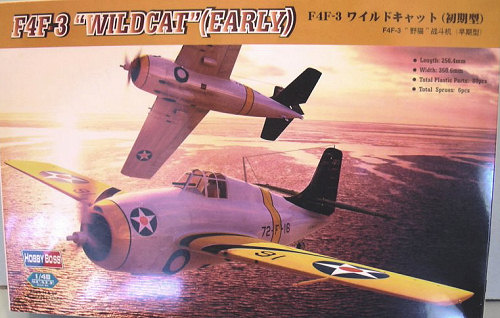
Hobby Boss 1/48 F4F-3 Wildcat 'early'
| KIT: | Hobby Boss 1/48 F4F-3 Wildcat 'early' |
| KIT #: | 80326 |
| PRICE: | 3,000 yen at www.hlj.com |
| DECALS: | Two options |
| REVIEWER: | Tom Cleaver |
| NOTES: |

| HISTORY |
The F4F‑3 "Wildcat" was the outcome of a development process by Grumman in response to a 1938 U.S. Navy requirement for a replacement for the F3F series. The Navy - while desiring a monoplane fighter that would be close in performance to its land‑based opponents - was also conservative in its planning; Grumman, the company that had created the F3F, was asked to create another biplane fighter ‑ the XF4F‑1 ‑ while Brewster would build a monoplane, the XF2A‑1. Grumman saw correctly that the biplane was a dead‑end, and managed to convince the Navy that with a few modifications, the F3F‑2 could meet the requirements of the XF4F‑1; this was ordered into production as the F3F‑3, and Grumman was able to proceed with its own monoplane design, the XF4F‑2.
How it was that the XF4F‑2, designed and built by the Navy's premier fighter design company, lost out to the XF2A‑2 ‑ the first aircraft design of a company primarily known for building horse‑drawn buggies, a company with no experience of aircraft production or possessed of the facilities to do so ‑ is one of those bureaucratic mysteries that has never been fully explained, the moreso since both aircraft were so close in performance that they were twins.
Luckily for the Navy and history, Grumman convinced the Bureau of Aeronautics to allow them to rework the design a third time, to create the XF4F‑3. This fighter was a marginally‑better performer than the F2A‑1, which had just entered production; Brewster was already demonstrating its inability to meet any production schedules, and the Navy was glad to be able to order the new fighter from the more reliable company.
The first production F4F‑3 was flown in February 1940, powered by a Pratt and Whitney R‑1830‑76 Twin Wasp with a two‑ stage supercharger, with the second following that July. These and the next eight F4F‑3s were involved in tests by the Navy to change the cooling flaps and exhaust to get rid of exhaust seepage in the cockpit and to improve engine cooling. In April 1940, due to fears of production delays with the two‑stagesupercharger, the Navy asked Grumman to change the airplane to use the R‑1830‑90 Twin Wasp with single‑stage supercharger.
This emerged as the F4F‑3A, 55 of which were given to the Marines in 1941, since they had shown they did not have the necessary high‑altitude performance with the single‑stage supercharger. AVG ace Charles Older once told me that one of the reasons he volunteered for the AVG was that he didn’t want to go into combat in the F4F-3A after once losing a “dogfight” with a USAAC P-40C in early 1941.
The last 100 F4F‑3s were changed to use the R‑1830‑86 Twin Wasp with a two‑stage supercharger; these were visually different from the early F4F‑3s and F4F‑3As by the absence of the intake on the upper cowling, that having been moved inside the cowl, and the presence of additional cowling flaps.
VF-41 became operational with VF‑41 aboard the "Ranger" on December 4, 1940. VF-41 was followed soon after by VF‑42 aboard “Yorktown,” followed closely by VF‑71 and VF‑72 aboard the "Wasp" in February 1941. VF‑6 turned in their F3F‑2s for F4F‑3s in June 1941, while VF‑3 exchanged their F2A‑1s for F4F‑3s in October 1941, as did VF‑5. VMF‑121 and VMF‑211 were equipped with F4F‑3s while VMF‑111 flew the F4F‑3As. In November 1941, the airplane received the emotive name "Wildcat."
| THE KIT |
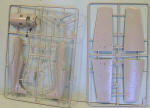
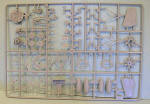 The only
other F4F-3 kits that have been released are the 1/32 scale early and late
F4F-3s by Trumpeter, and a 1/72 scale “F4F-3" by Hasegawa that is really just
their F4F-4 kit with different decals and instructions on filling in the extra
gun and folding wing panel lines. This 1/48 kit by Hobby Boss (a company owned
by the same furniture manufacturer that owns Trumpeter. Ed) is the first full
kit of the F4F-3 in this popular scale.
The only
other F4F-3 kits that have been released are the 1/32 scale early and late
F4F-3s by Trumpeter, and a 1/72 scale “F4F-3" by Hasegawa that is really just
their F4F-4 kit with different decals and instructions on filling in the extra
gun and folding wing panel lines. This 1/48 kit by Hobby Boss (a company owned
by the same furniture manufacturer that owns Trumpeter. Ed) is the first full
kit of the F4F-3 in this popular scale.
On opening the box, the Trumpeter ancestry is immediately apparent, with surface detail that is highly reminiscent of the larger kits. Additionally, the well-molded one-piece cowling is pure Trumpeter (and I mean that as a compliment). The fact that the Tamiya Wildcat was studied is also apparent, with the fuselage assembly even having the separate lower section that was part of the one-piece lower wing of the Tamiya kit. Trumpeter and Hobby Boss avoid copyright infringement here by having the wings separate, which means a modeler could get the dihedral wrong, something that was impossible with the Tamiya kit. The fabric detail is a bit overdone, and I do wish that the raised-rivet detail of the Tamiya kit, and the lapped fuselage panels - which are correct for the Wildcat - had been copied here, but one can’t have everything. I particularly liked how the very delicate landing gear parts are wrapped in padding to protect them from breakage in the box. The Hobby Boss kit also gets the Wildcat cockpit right, with the “look down” floor that Tamiya missed. The kit canopy looks like it can be positioned in the open position accurately, which cannot be done with the Tamiya kit.
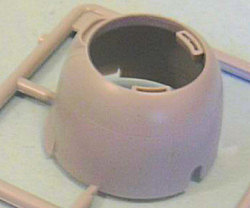 What is here is a very nicely-detailed
kit of this important version of the Wildcat. The F4F-3 had several different
cowlings over the course of its
What is here is a very nicely-detailed
kit of this important version of the Wildcat. The F4F-3 had several different
cowlings over the course of its 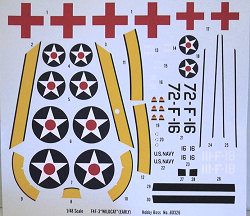 production,
and this one is right for this early version. The separately-molded windscreen
has an opening for the telescopic gunsight. Decals provide markings for an
F4F-3 of VF-72 aboard the USS Wasp circa early 1941 in “Golden Wings” Neutrality
Patrol markings, and an overall light-grey F4F-3 from VMF-111 with the red
crosses these aircraft wore during the 1941 War Games. These decals get it
right as to proportions of insignias and numbers, which means we might see
further improvement in Trumpeter’s decals in larger scales.
production,
and this one is right for this early version. The separately-molded windscreen
has an opening for the telescopic gunsight. Decals provide markings for an
F4F-3 of VF-72 aboard the USS Wasp circa early 1941 in “Golden Wings” Neutrality
Patrol markings, and an overall light-grey F4F-3 from VMF-111 with the red
crosses these aircraft wore during the 1941 War Games. These decals get it
right as to proportions of insignias and numbers, which means we might see
further improvement in Trumpeter’s decals in larger scales.
The next Hobby Boss release is an F4F-4, so it may be awhile before one sees the “combat” F4F-3. One could easily do this version by combining the Hobby Boss kit’s wings with the Tamiya F4F-4.
| CONCLUSIONS |
This is an excellent kit of the early F4F-3. The kit is well-engineered, provides good detail, and looks like it will be an easy project for those whose time is limited. Highly recommended.
Review Kit courtesy of HobbyLink Japan. Get yours at www.hlj.com
November 2007
If you would like your product reviewed fairly and quickly, please contact me or see other details in the Note to Contributors.